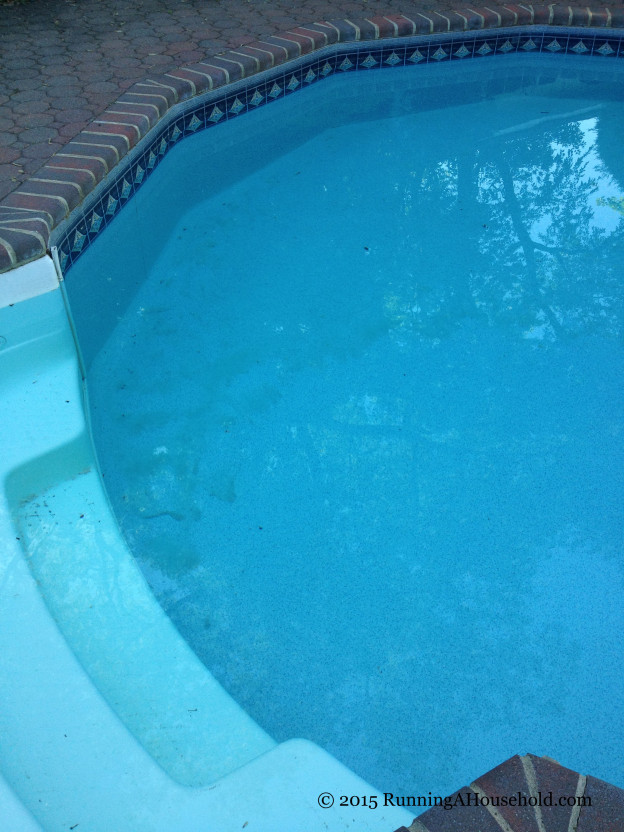Does it feel like you keep adding chlorine to your pool? Or does it seem like you can’t keep chlorine in your pool? If so, your pool may contain a high level of phosphates. We’re here to explain phosphates as well as tips to remove phosphates from your pool water.
What are Phosphates and Where Do They Come From?
Phosphates are an ingredient found in fertilizer. Phosphates can also come from organic matter, such as decayed leaves in your pool. Another source of phosphates is cosmetic products from bathers. Some pool products meant to descale your pool even contain phosphates.
Can’t Keep Chlorine in Your Pool?
Signs of high phosphate level in pool water
- Slimy walls
- Cloudy water
- Algae grows back quickly
- Chlorine seems to disappear from pool instantly
- Water testing shows high level phosphates
Disclaimer: Some of the links below are referral links, which means that if you make a purchase, there is no extra cost to you, but Running A Household will receive a commission.
How to Remove Phosphates From Your Pool
Step 1: Have the phosphate level in your pool water tested.
Phosphate levels should be below 100 ppb (parts per billion) or 0.100 ppm (parts per million). You can have your local pool store run a test, or you can purchase your own Phosphate Test Kit.
If phosphate levels are higher than 100 ppb, a phosphate remover called Phos Free Pool Cleaner can be purchased. This comes in a three liter bottle.
Read the application instructions to determine how much phosphate remover you need. Our pool is 16 x 36, and our phosphate level required us to use 32 ounces.
Step 2: Balance Your Pool Water
We made sure that our pool water was balanced first, with the exception of the chlorine level. So that means our alkalinity, ph, and calcium hardness were at the correct levels. We also added our three-month algaeside to prevent any further issues.
Our pool store representative recommended holding off on shocking the pool until our phosphate levels were reduced to close to 0. Otherwise, it’s like throwing money away. All of the shock you put into your pool will simply disappear. To drive the point home, he told us to just give him $20 if we felt like shocking the pool!
Step 3: Pour the Phosphate Remover around the entire pool.
The instructions on our phosphate remover product recommended that we pour the phosphate remover around the edge of the entire pool.
Also note that the filter will need to run for 24 hours, so plan accordingly. You will want to be around while the filter runs, so that you can bump it when the pressure rises.
Step 4: Vacuum up any phosphate remainder
Phosphate remnants look like gray or white matter floating at the bottom of the pool. You will need to vacuum this matter and remove it from your pool.
Step 5: Backwash the pool filter
It is important to backwash the pool filter after vacuuming, and install fresh Dichotomous Earth (D.E.) Backwashing will remove the phosphates from your pool, and prevent them from reentering the water. We even took the opportunity to crack open our filter to clean the fingers.
Step 6: Re-Test the Phosphate Levels
Next, have the phosphate levels tested again. If the levels are above 500, repeat the steps again. Otherwise, your pool will not hold chlorine. Since removing phosphates requires you to test multiple times, you may want to save a few trips to the pool store and purchase your own Phosphate Test Kit. We like this kit because it provides you with a color coded strip so that you can see the phosphate level:
Clear test results means there are no phosphates in your pool. The higher up on the blue scale you go, the more phosphates you have in your pool water. This kit also allows you to test up to 100 times. Hopefully you won’t need to test that many times, but it will certainly save you a few trips back and forth to the pool store.
Step 7: Shock Your Pool
Once your phosphate levels are close to zero, it’s time to shock the pool. As you now know, if the phosphate levels are too high, your chlorine will disappear.
Still having water issues? You may want to work with your local pool store to test the water. They have the technology to perform tests beyond the standard homeowner tests.
Happy swimming!




